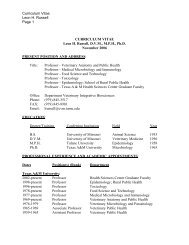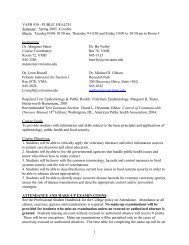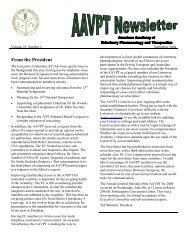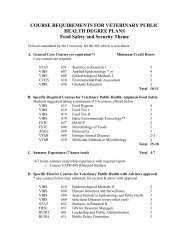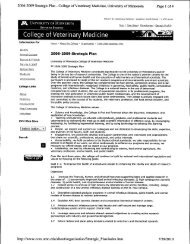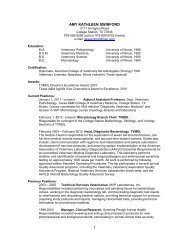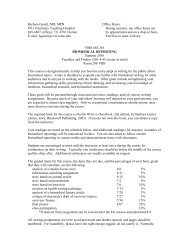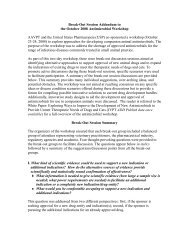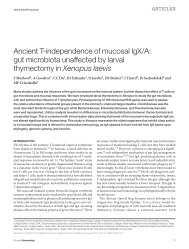Download PDF - College of Veterinary Medicine - Texas A&M ...
Download PDF - College of Veterinary Medicine - Texas A&M ...
Download PDF - College of Veterinary Medicine - Texas A&M ...
Create successful ePaper yourself
Turn your PDF publications into a flip-book with our unique Google optimized e-Paper software.
Faculty/Staff Focus<br />
Dr. Sharman Hoppes selected as president-elect <strong>of</strong> AAV<br />
Dr. Sharman Hoppes, associate<br />
pr<strong>of</strong>essor at the <strong>Texas</strong> A&M <strong>College</strong><br />
<strong>of</strong> <strong>Veterinary</strong> <strong>Medicine</strong> & Biomedical<br />
Sciences (CVM), was recently selected<br />
as the president-elect <strong>of</strong> the Association<br />
<strong>of</strong> Avian Veterinarians (AAV). Her<br />
tenure as president will be three years.<br />
Hoppes joined the CVM in 2006 in<br />
the Zoological <strong>Medicine</strong> Department<br />
<strong>of</strong> Small Animal <strong>Medicine</strong> where her<br />
research focuses on Avian Bornavirus,<br />
proventricular dilation disease, and<br />
behavior, training, and enrichment <strong>of</strong><br />
exotic pets and birds.<br />
The AAV, established in 1980, has a<br />
membership composed <strong>of</strong> veterinarians<br />
from private practices, zoos, universities<br />
and industry, as well as allied<br />
personnel, technicians, and students.<br />
Its mission is to advance and promote<br />
avian medicine and stewardship<br />
throughout the veterinary pr<strong>of</strong>ession.<br />
The AAV is one <strong>of</strong> the American <strong>Veterinary</strong><br />
Medical Association’s (AVMA)<br />
continued from page 54<br />
Dr. Hoppes with Angel<br />
help initiate an education outreach<br />
program and an action plan for ocelot<br />
management.<br />
“Ocelot conservation is occurring<br />
on several fronts,” Tewes said. “I have<br />
formed a group <strong>of</strong> ranchers who are<br />
interested in learning about ocelot<br />
ecology or surveying for ocelots on<br />
their property. The key to ocelot<br />
recovery will be private landowners<br />
who own most <strong>of</strong> the land occupied by<br />
major resources on bird-related issues<br />
and educates veterinarians on avian<br />
care.<br />
Originally, Hoppes did not see<br />
herself specializing in a particular field<br />
<strong>of</strong> veterinary medicine. “When I first<br />
started my veterinary career, I wanted<br />
to treat everything. But in my first practice,<br />
we saw dogs, cats, birds, and exotic<br />
pets, and birds were the most challenging<br />
because no one knew much about<br />
them at the time,” Hoppes said. “If they<br />
needed surgery, we couldn’t really find<br />
anyone unless we sent clients out <strong>of</strong><br />
state.”<br />
Hoppes said the AAV began as a<br />
dialogue between veterinarians who<br />
treated birds in mixed practices but<br />
needed more information on specific<br />
avian medical cases. “There was simply<br />
very little information out there on<br />
avian veterinary care. Everyone was<br />
struggling,” Hoppes said. Now the AAV<br />
is one <strong>of</strong> the leading exotic organizations,<br />
and one <strong>of</strong> two with representation<br />
within the AVMA.<br />
Hoppes received her DVM from<br />
Oklahoma State University in 1993.<br />
She attended her first AAV meeting in<br />
1995, and completed an avian medicine<br />
and surgical residency in 1999, at<br />
North Carolina State University. Perhaps<br />
one <strong>of</strong> the most pivotal moments<br />
in becoming an avian veterinarian<br />
was when Hopes became a bird owner<br />
herself.<br />
“I adopted a cockatoo named Angel<br />
from a client who couldn’t take care<br />
<strong>of</strong> her anymore. The owner simply<br />
couldn’t handle her,” Hoppes said.<br />
“Adopting Angel completely changed<br />
my life and inspired me to be more<br />
involved with avian research and education.”<br />
Hoppes said she believes that<br />
most difficulties with birds originate<br />
with behavioral issues, much like those<br />
ocelots. We continue to document new<br />
ranches where ocelots occur, a process<br />
fundamental to their recovery. And we<br />
are monitoring their population size<br />
and change over different conditions<br />
such as drought. Eventually, we believe<br />
it is important to augment the existing<br />
ocelot populations in <strong>Texas</strong> in order to<br />
alleviate the problems associated with<br />
low genetic diversity identified in our<br />
collaborative research.”<br />
This research indicates that the extinction<br />
rates in <strong>Texas</strong> have exceeded<br />
Dr. Sharman Hoppes<br />
experienced between Angel and her<br />
first owner. Hoppes attributes this difficulty<br />
to the intelligence <strong>of</strong> the animals;<br />
that, combined with the general lack <strong>of</strong><br />
education in avian behavior and medicine,<br />
makes veterinary care for birds<br />
challenging. Angel inspired Hoppes to<br />
become residency-trained and boarded<br />
in avian medicine, which led to her being<br />
an active member in AAV.<br />
Hoppes’ first position within the<br />
AAV was as chair <strong>of</strong> the Avian Rescue<br />
and Sanctuary Ad Hoc Committee. She<br />
later served on the Board <strong>of</strong> Directors.<br />
“I am so excited to serve as presidentelect.<br />
Over the last six to seven years,<br />
I really hoped I might reach this position,<br />
and I am so excited about what<br />
I can contribute to the association,”<br />
Hoppes said.<br />
the rate <strong>of</strong> colonization, as populations<br />
have become reduced in abundance<br />
and distribution. Janecka and his<br />
team understand that the ocelot is an<br />
important part <strong>of</strong> the natural history <strong>of</strong><br />
<strong>Texas</strong>. Janecka hopes that, with the research<br />
<strong>of</strong> his team, the work <strong>of</strong> the Caesar<br />
Kleberg Wildlife Research Institute,<br />
and the cooperation <strong>of</strong> the landowners,<br />
the ocelot’s majestic beauty will be<br />
visible for <strong>Texas</strong> generations to come.<br />
CVM Today • Winter 2012 • 55




